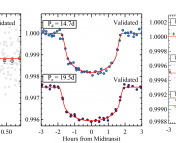The Undergraduate Research series is where we feature the research that you’re doing. If you are an undergraduate that took part in an REU or similar astro research project and would like to share this on Astrobites, please check out our submission page for more details. We would also love to hear about your more general research experience!
Meredith Vogel
Missouri State University

Meredith Vogel is in her last semester at Missouri State University studying Physics and Astronomy. She completed this research with Dr. Sarah Morrison at Missouri State University and is funded by a NASA- Missouri Space Grant.
What makes a planet habitable? A habitable planet needs to have a rocky surface, be far enough away from its host star for it to support liquid water on its surface, and lastly, have a stable climate. My research is looking to better define a habitable zone planet; specifically, with orbit changes due to other planets in the system. A planet’s orbit can change due to other planets because of gravitational forces between them. If a neighboring planet is massive and close in orbit to the planet in question, the orbit of that planet is more likely to go through changes over time. I investigated how the orbits of planet perturbers can change the orbit and potentially the climate of a habitable zone planet orbiting near the inner edge of a calculated habitable zone.
Habitable zone planets orbiting around the inner edge of the habitable zone face a greater threat to habitability because of the risk of runaway greenhouse effect. The runaway greenhouse effect occurs when a planet’s atmosphere holds enough greenhouse gases like carbon dioxide and blocks thermal radiation from the planet that allows it to cool. Planets perturbing a planet near the inner edge of the habitable zone may have more of an effect on its climate than if that planet were further within the habitable zone. Planets near the inner edge of the habitable zone are more susceptible to the runaway greenhouse effect, whereas planets near the outer edge of the habitable zone may still maintain a robustly habitable climate even with an eccentric orbit extending beyond the outer ‘boundary’.
I calculated habitable zones for different stellar temperatures and then simulated the orbits of 2 Kepler observed systems, K2-3 and GJ 3293, two systems with planets whose orbit spacings were relatively close together. I found that exoplanets stay in their calculated habitable zones but may have underlying orbital changes that could influence the climate of the planet, which requires further investigation. My research with the orbits of these systems can be used as an input for climate models to further analyze how an exoplanet’s climate changes within its calculated habitable zone.
The orbits are stable over the million year time scale and the habitable zone planets stay in their calculated habitable zones. The systems studied in my research are billions of years old, and since they were observed by Kepler and confirmed, their orbits must be stable i.e. no planet ejection. Although there were not large changes in the orbits of the habitable zone planets, there may be more subtle effects in play that require further investigation and these effects could classify the habitable zone planet as not habitable.

Astrobite edited by: Ellis Avallone




